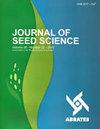Artificial neural networks discriminate lettuce seeds with different levels of thermoinhibition
IF 1.2
4区 农林科学
Q3 AGRONOMY
引用次数: 0
Abstract
Abstract: The thermoinhibition of lettuce seed germination causes important losses for producers, who do not have thermotolerant commercial cultivars. One of the obstacles has been the scarcity of optimizing techniques capable of efficiently discriminating thermotolerant and thermosensitive cultivars. The aim of this work was to evaluate the use of neural networks to discriminate different levels of thermoinhibition in lettuce seeds. Seeds of 18 cultivars were evaluated for thermoinhibition considering the characteristics of the first and last germination count and germination speed index, in seeds subjected to temperatures of 20, 25, 30 and 35 °C. The remaining seeds, which did not germinate, were subjected to the tetrazolium test. Analyses were performed immediately after seed harvesting and repeated after six months of storage. Discriminant analysis was performed and the Kohonen’s Self-Organizing Map (SOM) was created using Artificial Neural Networks (ANNs). Neural networks discriminate lettuce cultivars and organizes them in terms of seed thermoinhibition tolerance through Kohonen’s Self-Organizing Map. Discriminant analysis consistently identifies the Everglades and Luiza genotypes as tolerant to thermoinhibition.人工神经网络对不同热抑制水平的生菜种子进行了判别
摘要:生菜种子萌发的热抑制给生产者造成了重大损失,因为他们没有耐热的商业品种。其中一个障碍是缺乏能够有效区分耐热和热敏品种的优化技术。这项工作的目的是评估使用神经网络来区分生菜种子中不同程度的热抑制。研究了18个品种的种子在20、25、30和35℃温度下的初、末萌发数和萌发速度指数特征。其余未发芽的种子进行了四氮唑试验。在种子收获后立即进行分析,并在储存六个月后重复分析。采用人工神经网络(ann)进行判别分析,建立Kohonen自组织图(SOM)。神经网络通过Kohonen的自组织图对生菜品种进行分类,并根据种子的热抑制耐性对其进行组织。判别分析一致确定Everglades和Luiza基因型对热抑制具有耐受性。
本文章由计算机程序翻译,如有差异,请以英文原文为准。
求助全文
约1分钟内获得全文
求助全文
来源期刊

Journal of Seed Science
Agricultural and Biological Sciences-Agronomy and Crop Science
CiteScore
2.00
自引率
30.00%
发文量
28
审稿时长
12 weeks
期刊介绍:
From 2017 the Journal of Seed Science (JSS) will circulate online version only.
Original scientific studies and communications, not yet published or submitted to another journal for publication and written in Portuguese or English, will be accepted for publication. For manuscripts submitted in English, the authors should provide an adequated version.
The SCIENTIFIC COMMUNICATION is a category of scientific manuscript which describes a technique, an equipment, new species or observations and surveys of limited results. It has the same scientific rigor as the “Scientific Articles” and the same value as a publication. The classification of a manuscript as a SCIENTIFIC COMMUNICATION is based on its content and scientific merit but it can be a preliminary study, simple and not definitive on a certain subject, with publication justified by its uniqueness and contribution to the area.
The Editorial Board of the JSS may invite leading authors of recognized reputation to compose specific Review Articles covering topics of their specialization that will convey to the scientific community the state-of-the-art knowledge related to the specific theme.
 求助内容:
求助内容: 应助结果提醒方式:
应助结果提醒方式:


